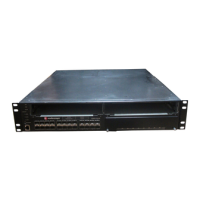show ipv6 ospf
19-28 OSPFv3 Configuration
Defaults
None.
Mode
Routerprivilegedexecution:G3(su)‐>router#
Example
ThisexampleshowshowtodisplayOSPFv3routerinformation.
G3(su)->router# show ipv6 ospf
Router ID 2.2.2.2
OSPF Admin Mode Enable
ASBR Mode Enable
ABR Status Enable
Exit Overflow Interval 0
External LSA Count 0
External LSA Checksum 0
New LSAs Originated 89
LSAs Received 177
External LSDB Limit No Limit
Default Metric Not Configured
Maximum Paths 4
Default Route Advertise Disabled
Always FALSE
Metric
Metric Type External Type 2
Table 19‐1providesanexplanationofthecommandoutput.
Note: Some of the information in Table 19-1 displays only if you enable OSPFv3 and configure
certain features.
Table 19-1 show ipv6 ospf Output Details
Output Field What It Displays...
Router ID A 32 bit integer in dotted decimal format identifying the router,
about which information is displayed. This is a configured value.
OSPF Admin Mode Whether the administrative mode of OSPF in the router is enabled
or disabled. This is a configured value.
ASBR Mode Whether the ASBR mode is enabled or disabled. Enable implies
that the router is an autonomous system border router. Router
automatically becomes an ASBR when it is configured to
redistribute routes learnt from other protocol. The possible values
for the ASBR status is enabled (if the router is configured to re-
distribute routes learnt by other protocols) or disabled (if the router
is not configured for the same).
ABR Status Whether the router is an OSPF Area Border Router.
Exit Overflow Interval The number of seconds that, after entering Overflow State, a
router will attempt to leave Overflow State.
External LSA Count The number of external (LS type 5) link-state advertisements in
the link-state database.
External LSA Checksum The sum of the LS checksums of external link-state
advertisements contained in the link-state database.

